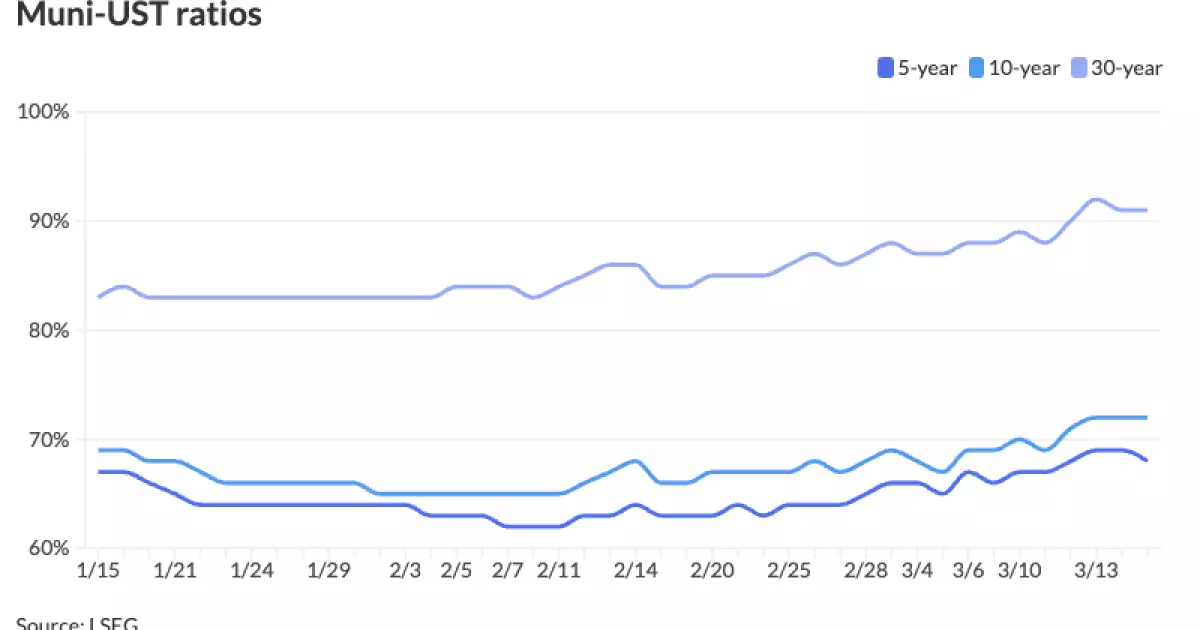The municipal bond market is currently grappling with a tumultuous landscape that combines both volatility and opportunity. As observed recently, yields have risen sharply, with an average increase of 15.1 basis points, painting a disconcerting picture for investors. The past week has been tumultuous; municipalities witnessed a steep decline as the balance of supply versus demand tilted unfavorably. Coupled with disappointing CPI data and rumors surrounding presidential tariffs, it marks a critical juncture in which investors must tread carefully. Many seasoned analysts, including Jason Wong from AmeriVet Securities, have characterized the current conditions as perilous, advising against complacency.
Moreover, as munis now reflect a meager return of just 0.07% for 2025, month-to-date losses have accumulated to 1.41%. It’s a stark reminder that the comfort of low yields can be deceptive, as risks loom ominously from multiple angles. Can one still hold an optimistic outlook in such a fraught environment?
Yields and Ratios: The Silver Lining?
Despite the gloomy landscape, some interpret the current yield ratios as an enticing opportunity for strategic investors. At 91% for the 30-year municipal to U.S. Treasury (UST) ratio, it is evident that these instruments are now at their most competitively valued in over a year. A discerning eye will note that long-dated munis offer potential rewards, especially if one can weather the immediate turbulent conditions.
Investors with a keen sense of the market have started to recognize that, while volatility is expected to linger, considering currently discounted munis could lead to rewarding long-term gains. The average 10-year muni ratios, stable at 72%, signify prospective buyers may find value in mispriced assets. It begs the question: is it wise to consider these ratios as merely numbers, or do they signal the beginning of an upswing for strategic investors willing to brave the storm?
The Role of Mutual Funds: Challenges Abound
The recent outflow of $373 million from municipal mutual funds, particularly from investment-grade categories, highlights mounting structural challenges. Birch Creek’s analysis reveals a staggering 31% rise in customer apprehensions, resulting in vast increases in bid-wanted lists—a troubling sign for market liquidity. With inflows dwindling, the hint of an uphill battle in the market becomes more pronounced.
These outflows underscore the elemental tension faced by investors who prioritize quality over quantity. The increased focus on new issues reflects a need for value amidst declining demand, suggesting a trend toward greater selectivity among buyers. The market’s weakness fuels a cycle of hesitation, forcing investors to make calculated decisions driven by fear rather than confidence. The implications are clear: waiting for the market to stabilize could potentially yield rich dividends for the patient and discerning investor.
Upcoming Opportunities: What Lies Ahead?
Despite the current challenges, the primary market is busy as it prepares to issue significant bonds across various sectors. Anticipation surrounds the municipal offerings from the Alabama Federal Aid Highway Finance Authority and the San Diego Unified School District. Major players, such as BofA Securities and Jefferies, are gearing up for a competitive bond issuance, indicating resilience within the issuance framework.
While there may be trepidation about the concentration of issued bonds amid shaky demand, these transactions also signify potential for investors who can navigate this challenging environment. Each bond is a unique opportunity that could lead to favorable yield results for the longer term, suggesting those willing to analyze and adapt strategies will be the ones to reap substantial benefits.
The Volatility Factor: A Call to Action or A Warning Sign?
Volatility may be a seasoned player in the municipal bond market, but it also serves as a vital call to action for investors. With indications of a weak technical landscape ahead, embracing this volatility rather than yielding to it can be a decisive advantage. Strategic purchasing in these downtrends may allow astute investors to acquire undervalued assets for sustained growth in the future.
Critics may argue that such an approach is fraught with risks, yet, as the adage goes, fortune favors the bold. The insistence on waiting for market certainty may cause investors to miss out on significant returns, reminding us that while caution is sensible, overly conservative strategies could hinder long-term performance.
The municipal bond market is a complex tapestry of risks and opportunities. The present climate demands careful analysis and strategic decision-making from investors who wish to navigate through uncertainty for potential future gains.

